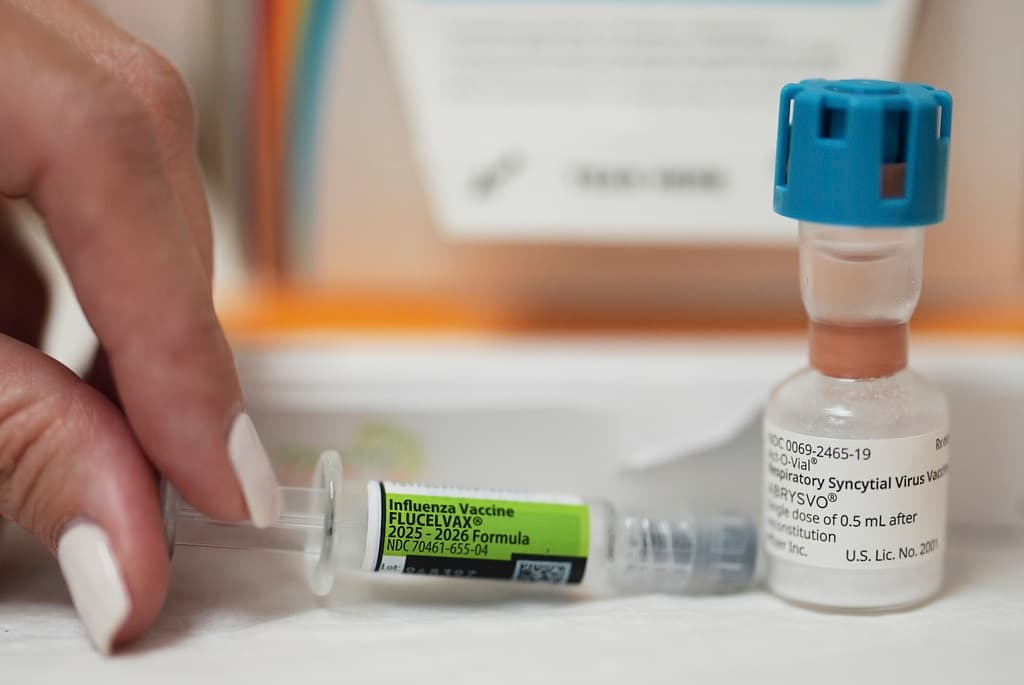
One of the most accomplished diplomats in American history became a U.S. citizen in Colorado in 1957.
Madeleine Albright, who died Wednesday at 84 years old, would go on to win the Presidential Medal of Freedom after serving as the nation’s first female Secretary of State. She began her journey at a courthouse in Denver.
“When I come to Denver I always somehow go by the courthouse,” Albright told CPR in 2008 while in town for the Democratic National Convention.
“I loved becoming an American. And one of the things I did, on July 4, 2000, at Monticello -- Thomas Jefferson’s home -- we swore in a whole new group of American citizens. I handed them their papers and I said to them, ‘I have a piece of paper just like this, and it’s the most valuable piece of paper you’ll ever have.”
Albright, born in Prague, had immigrated to the U.S. from Czechoslovakia at the conclusion of the Second World War. Her father, Josef Korbel, had served the exiled Czech government in Great Britain during the Nazi occupation of his homeland. Then, shortly after returning to Prague, a communist takeover of the government helped build the Iron Curtain, and the Cold War began.
The family could not stay in Czechoslovakia.
Albright and her mother, Anna Korbel, took a ship to Ellis Island and landed on Armistice Day, November 1, 1948. Her father joined them soon after.
After months of applying for political asylum, Korbel’s diplomatic and academic bona fides landed him a job at the University of Denver.
“(Albright’s) mother said there were two great cities in this world, Prague, where they were from, and Denver,” said Frederick “Fritz” Mayer, Dean of the Josef Korbel School of International Studies — which was founded by Albright’s father in 1964 and subsequently named after him in 2008.
“They just loved it here.”
Albright’s fleeing of Soviet Communism and sudden arrival in the American West occurred during a formative time in her life, and it would foreshadow a career of championing democracy around the world.
Albright wrote of 1950s Denver: “It was quiet and friendly, and perfect for us…”
She took to being a Denverite during her 6 years in the city.
“I put my own twist on becoming a bona fide American teenager,” Albright wrote. “I spoke four languages — Czech, Serbo-Croatian, French, and English — but I didn’t yet speak American.”
Albright attended junior high at Morey and high school at Kent Denver School, then an all-girls school in Cherry Hills Village.
She played field hockey, attended glee club, and even played Mr. Bennet in a school production of “Pride and Prejudice.” She was elected to the school council in 10th grade but lost reelection — an early lesson in practical democracy. She also founded the school’s international relations club and won the Rocky Mountain Empire United Nations Contest, which she would boast about while serving as actual UN ambassador years later.
But despite the academic niche she carved for herself, Albright also dealt with the challenges of arrival in a new world. For her, this meant being an Eastern European, Catholic immigrant at a relatively well-to-do private, protestant school.
“Sometimes it seemed that the harder I worked to become a plain-vanilla American, the more my parents insisted on being their spicy selves,” Albright wrote.
Her family lived all over the city, moving often. Their stops included a home near the capitol and “a small bungalow near the University of Denver’s football stadium, between two parking lots that were filled on fall Saturdays.”
In 1955, she graduated with scholarships to Stanford, the University of Colorado, Mount Holyoke, the University of Pennsylvania and Wellesley College. She chose Wellesley and headed to Massachusetts.
But Colorado would never leave her. Her father worked at DU for decades more, establishing himself as a pillar of Denver. Her mother worked for Denver Public Schools as a secretary. Eventually, Albright also took a job for The Denver Post while home from college, and there, she met Joseph Medill Patterson Albright. They married in 1959 — and she converted to the Episcolpal Church.
Later, she would make another Colorado connection with another major diplomat, Condoleezza Rice.
“My father died in 1977 and at that time he already was pretty well known in Denver. And there were lots of tributes and flowers. And among the flowers was a ceramic pot in the shape of a piano with a variety of leaves in them,” Albright told Colorado Matters in 2008. “And I said to my mother, where did this come from? And she said, it's from your father's favorite student, Condoleeza Rice.
“I didn't know her until 1987, when I was working for Michael Dukakis… So I called her up and I said, ‘Would you like to be an advisor to Michael Dukakis?’ And she said, ‘Madeline, I don't know how to tell you this, but I'm a Republican.’ And I said, ‘’Condie, how could you be? We had the same father.’”
Both Coloradans would later serve as U.S. Secretaries of State.
Albright was inducted into the Colorado Women’s Hall of Fame in 2010. Two years later, the Denver Art Museum presented an exhibit dedicated to the jewelry pins Albright famously wore on her lapels.
In a statement memorializing her death, Governor Jared Polis highlighted Albright’s connections to the state and said “her life continues to teach our nation and the world lessons of determination, wisdom, and grace in times of peace or unrest.”
U.S. Sen. John Hickenlooper called her a “true giant” and “one of the great foreign policy voices of our time.”
“The thing about Madeleine, both in the time when she was Secretary of State, and then in the years after, is that her life experience prepared her to see things other people didn't see so clearly,” Mayer said. “She understood in her bones the great contest between democracy and autocracy and fascism, and that clear sightedness, that understanding of what is ultimately at stake, I think is her real legacy.”
Albright died Wednesday after a long fight with cancer.
CPR's Ryan Warner, Matt Bloom, Corey Jones and Caitlyn Kim contributed to this story.









